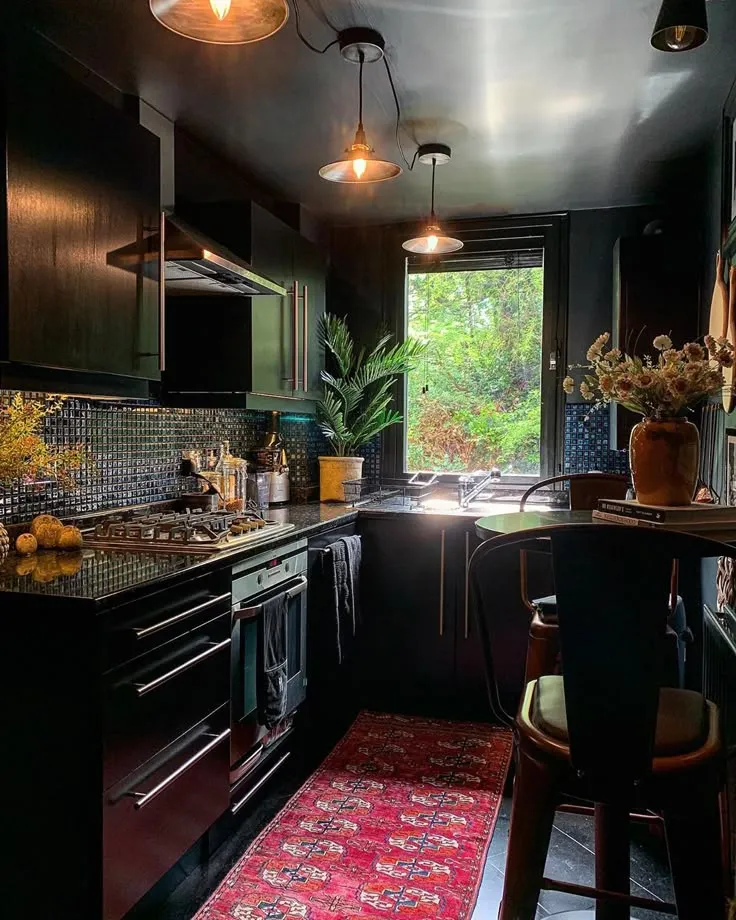The Allure of Black and White Gothic Kitchens
Gothic kitchen decor, particularly when executed in a stark black and white palette, offers a captivating blend of drama, elegance, and timelessness. This aesthetic draws inspiration from the medieval period, characterized by pointed arches, ornate details, and a sense of mystery. The monochrome scheme amplifies these features, creating a visually striking space that is both bold and sophisticated. The appeal lies in the contrast; the deep, enveloping darkness of black paired with the pristine purity of white. This creates an environment that is both inviting and intriguing, perfect for a kitchen that serves as the heart of the home while expressing a unique style. The black and white gothic kitchen isn’t just a design choice; it’s a statement about embracing the unconventional and celebrating the beauty of the past in a modern context.
Designing Your Gothic Kitchen in Black and White
Designing a gothic kitchen in black and white requires careful consideration of balance and contrast. The key is to avoid the space feeling too heavy or too sterile. Start by establishing the dominant color; this will influence the overall mood of the room. Black can be used strategically on cabinetry, countertops, or accent walls to create a sense of depth and drama. White, on the other hand, can brighten the space, used on walls, ceilings, and some of the cabinetry, reflecting light and making the kitchen appear larger. The interplay between these two colors is what defines the gothic style. Textures and materials are crucial; incorporating elements like dark, veined marble, wrought iron, and textured tiles can add visual interest and depth. Accessories like ornate chandeliers, antique-inspired faucets, and dramatic artwork can further enhance the gothic aesthetic, while maintaining a clean and uncluttered feel is essential to prevent the space from feeling overwhelming.
Color Palette for Gothic Kitchens
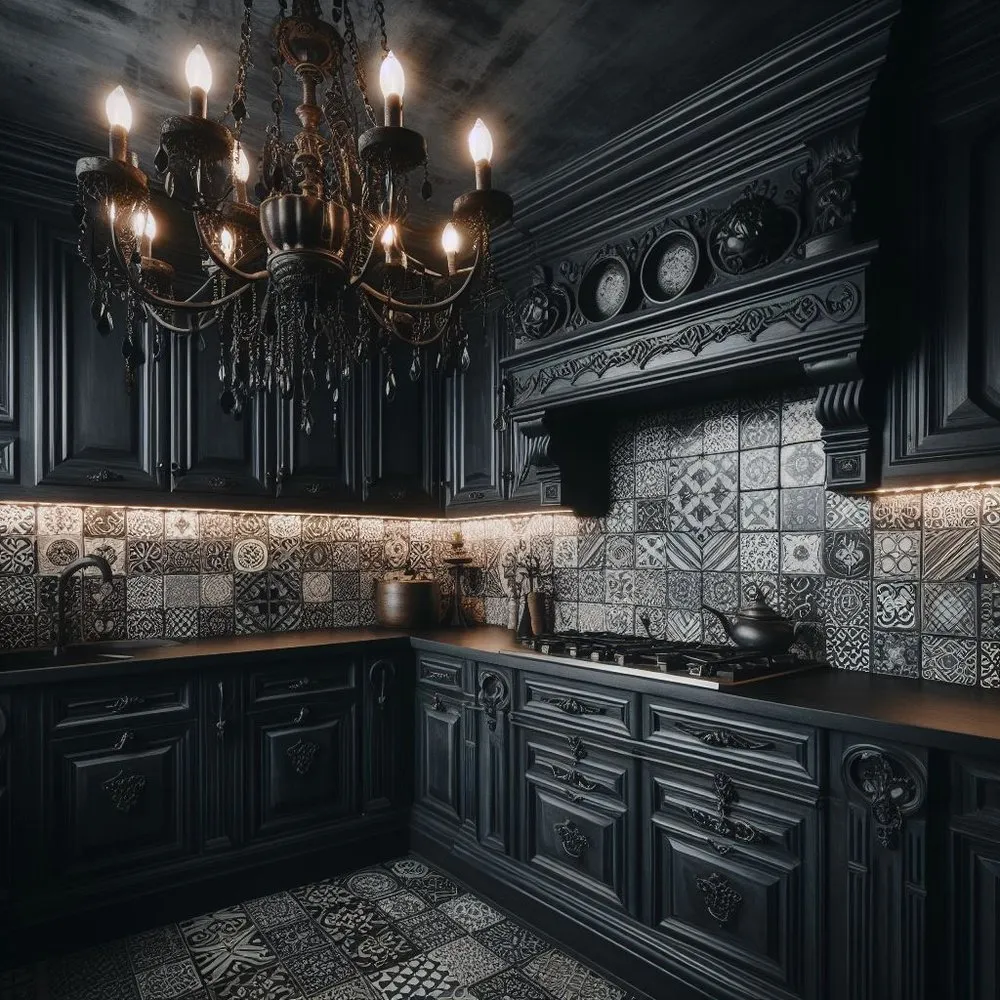
The core of a gothic kitchen’s color palette is, undeniably, black and white. However, it’s the nuances within this spectrum that truly bring the design to life. Different shades of black – from deep, matte charcoal to glossy ebony – can create varying effects. Using a variety of whites is equally important; consider creamy off-whites to soften the contrast, or bright whites for a more modern feel. Beyond black and white, accent colors can add personality. Deep jewel tones like ruby red, emerald green, or sapphire blue can be incorporated through accessories, textiles, or even a single statement piece. These colors add pops of vibrancy, echoing the stained glass of gothic architecture. Metallic accents, like silver or gold, can add a touch of luxury and further elevate the gothic aesthetic, but be mindful not to overdo it. The goal is a harmonious balance that respects the core black and white foundation.
Black’s Role in Gothic Decor
Black is the backbone of gothic design, providing a sense of depth, mystery, and sophistication. In the kitchen, black can be employed in various ways; consider black cabinetry, countertops, or even an entire black accent wall. The use of black creates a dramatic backdrop for lighter elements, highlighting the architectural details and decorative accents. Black absorbs light, which can make a room feel cozier and more intimate. When using black, it’s essential to consider the finish. Matte black surfaces can create a more subdued and elegant look, while glossy black adds a touch of luxury. The strategic placement of black is crucial. It can be used to ground the design, define spaces, and create focal points. Be cautious of using too much black in a small kitchen, as it could make the space feel smaller and darker. The key is balance, using black as a powerful tool to enhance the gothic atmosphere without overwhelming the space.
White’s Role in Gothic Decor
White is the counterpoint to black, providing a sense of airiness and luminosity. In a gothic kitchen, white can be used to brighten the space, reflect light, and create a sense of openness. White walls and ceilings can visually expand the room, while white cabinetry can create a clean and modern look. White can also be used to highlight the architectural details of the kitchen, such as ornate moldings or decorative tiles. The choice of white is important; consider using a warm white to soften the contrast with black or a cool white for a more modern aesthetic. White can be incorporated in various textures and finishes; from smooth, painted surfaces to textured tiles and fabrics. The thoughtful use of white is critical to balance the deep tones of black, prevent the space from feeling too dark, and create a welcoming environment. Using white strategically will ensure the kitchen feels both gothic and inviting.
Essential Elements of Gothic Kitchen Decor
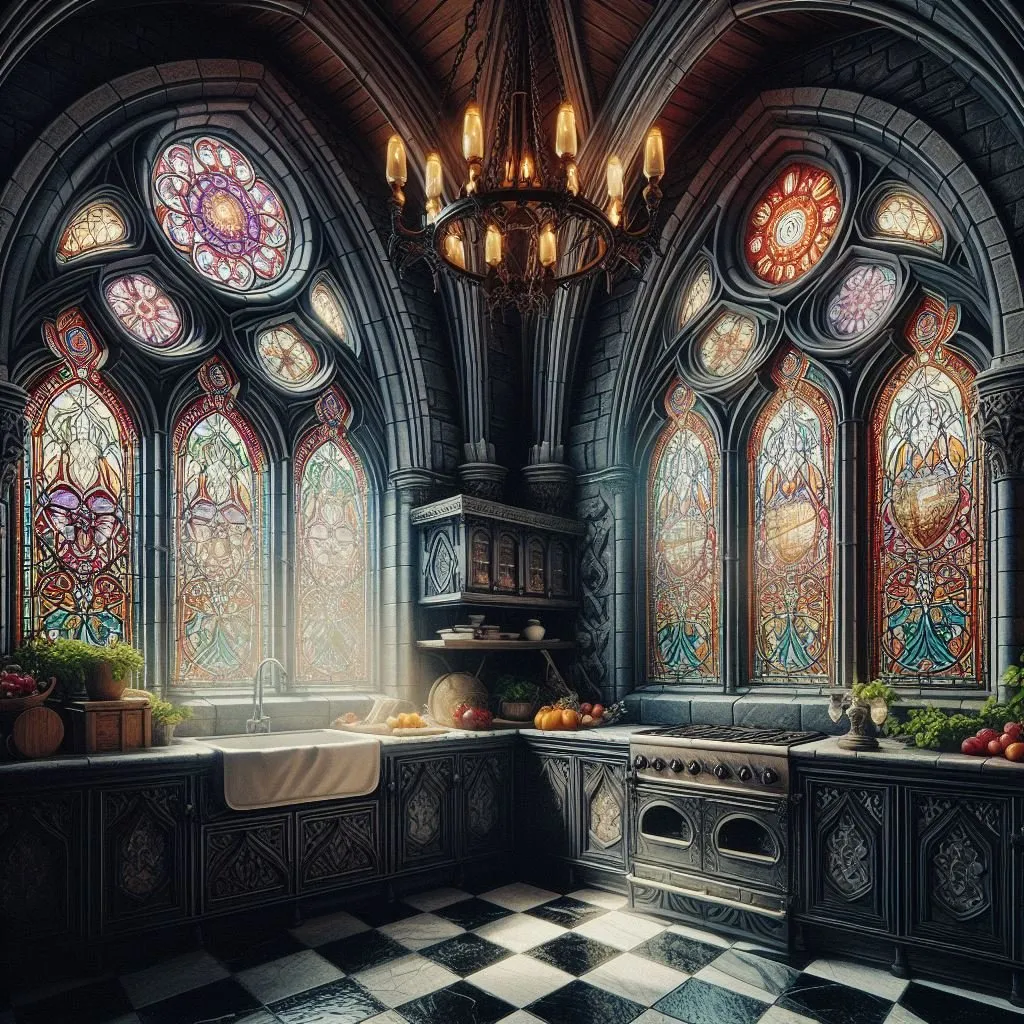
Several elements are crucial to achieving the gothic aesthetic in a kitchen. First, the architecture itself can influence the design, with pointed arches, vaulted ceilings, and detailed moldings adding to the gothic feel. Furniture and cabinetry are essential; consider dark, ornate cabinets with intricate carvings or panels. Countertops can be made of dark marble, granite, or even black quartz. Lighting is key, and chandeliers, especially those with a wrought-iron or crystal design, can create a dramatic focal point. Hardware and fixtures are important, with antique-inspired faucets and cabinet pulls adding to the period look. Decorative accents, such as antique mirrors, wrought-iron candle holders, and gothic-inspired artwork, can enhance the overall aesthetic. The choice of materials is also important; incorporating natural materials like stone, wood, and iron can add texture and authenticity to the design. Integrating these elements thoughtfully is key to a successful gothic kitchen design.
Furniture and Cabinetry in Gothic Kitchens
Furniture and cabinetry are at the heart of the gothic kitchen. The style often features dark wood cabinetry, stained or painted in black or deep shades of gray. The design details are often ornate, with carved panels, pointed arches, and elaborate moldings. Consider adding a kitchen island to add workspace and storage, it should mirror the design of the cabinetry, with dark tones and decorative details. The use of freestanding furniture, such as a large, antique-style table, can also enhance the gothic feel. The choice of materials for cabinetry is also essential. Dark wood, such as walnut or mahogany, adds to the gothic ambiance. The hardware should complement the overall design; consider wrought-iron or antique-style pulls and knobs. The design and selection of the furniture will establish the gothic character of your kitchen, providing functionality without sacrificing the thematic details that define gothic style.
Selecting Gothic Kitchen Furniture
Selecting furniture for a gothic kitchen involves considering the style, materials, and functionality. Look for pieces that reflect the architectural elements of the gothic period. Tables and chairs should feature dark wood, possibly with intricate carvings. Consider an antique table as a kitchen island or dining table to add to the aesthetic. The shape of furniture can also contribute to the gothic feel, pointed arches, and other curved shapes can complement the design. The furniture’s finish is important; dark stains or paint colors such as black, deep gray, or even burgundy are ideal. Materials should also reflect the gothic aesthetic, dark wood, wrought iron, and stone all help achieve the desired look. Focus on functionality, selecting pieces that meet your needs and can be integrated into the kitchen design. Combining these features will create a gothic kitchen full of functionality and style.
Cabinetry Styles in Gothic Design
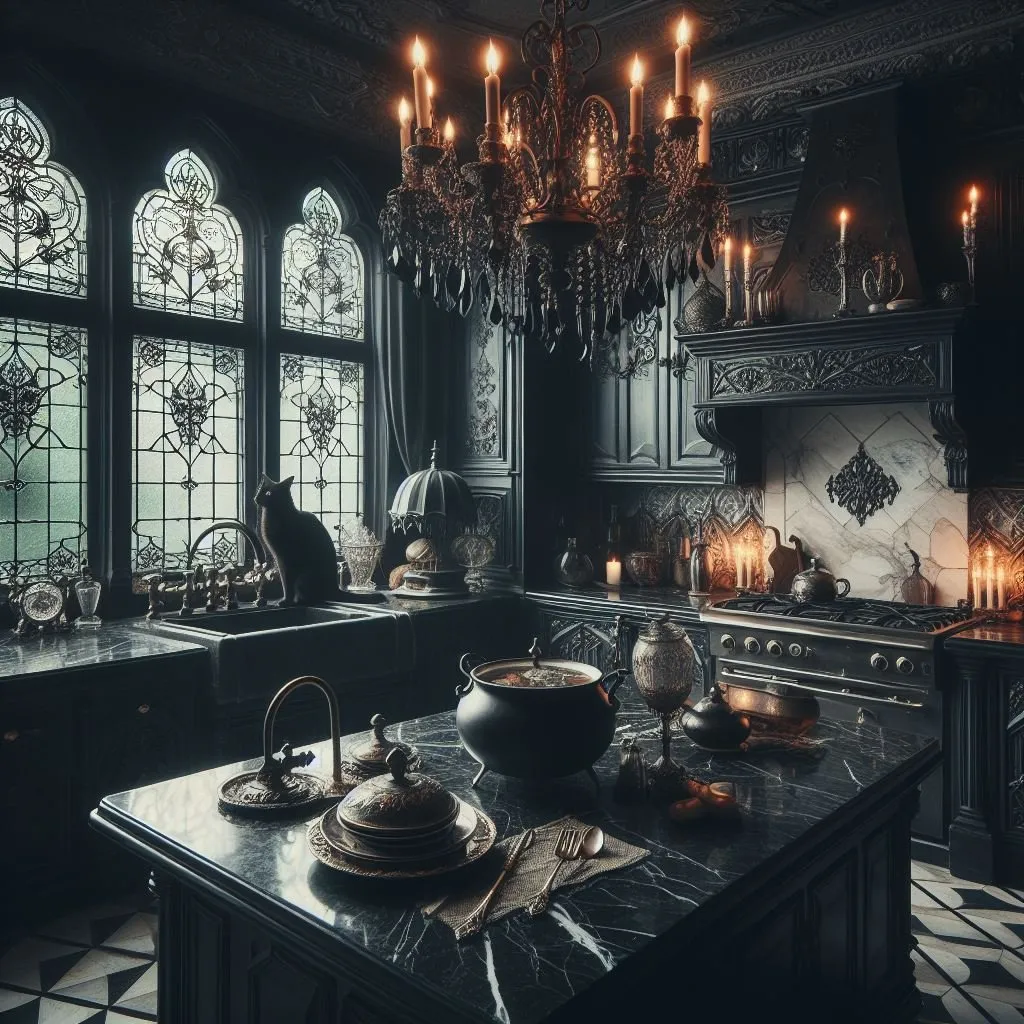
Cabinetry styles are important for the gothic look. There are a variety of options that include traditional styles such as raised panel doors, often featuring intricate carvings and molding details. These can be painted in black, dark grey, or deep, rich colors to achieve the gothic look. Another style to consider is flat-panel cabinetry, this option offers a modern take on gothic design by providing a sleek, minimalist style. You can also incorporate elements from different styles, combining the sophistication of gothic with the functionality of modern design. The hardware is also important, so choose hardware that enhances the gothic aesthetic. Wrought-iron handles and knobs add a classic touch. The overall style of your cabinetry will play a key role in forming the final look of your gothic kitchen. Selecting the proper style is essential to the overall look and feel of your kitchen.
Decorative Accents and Accessories for Gothic Kitchens
Decorative accents and accessories are the finishing touches that bring a gothic kitchen to life. Antique mirrors with ornate frames can reflect light and add a touch of drama. Consider displaying artwork with gothic themes, such as portraits, landscapes, or still lifes. Wrought-iron candle holders and candelabras can add a warm, inviting glow, while gothic-style clocks and figurines can add to the thematic look. Textiles can be incorporated to add texture and color, with velvet or damask fabrics in dark colors such as burgundy or deep green. The materials used for accessories can add to the gothic feel, such as wrought iron, stone, and wood. The placement of these items is also important; arranging them on countertops, shelves, or walls will enhance the overall aesthetic. Combining these elements will help create a kitchen that’s not only functional but also visually appealing and true to the gothic style.
Lighting for a Gothic Kitchen
Lighting is crucial in a gothic kitchen, as it sets the mood and enhances the atmosphere. Chandeliers, with their intricate designs and crystal accents, are a classic choice. Consider chandeliers made of wrought iron or with a black finish to complement the black and white color scheme. Pendant lights can be used to add a dramatic look, they can be placed over the kitchen island or dining area. Wall sconces can add ambient lighting and create a sense of intimacy. The light fixtures you choose will significantly impact your space’s mood. The use of dimmers is important, allowing you to adjust the intensity of the light to suit the time of day or the occasion. The type of light bulbs you use can also impact the aesthetic; warm-toned bulbs can create a cozy atmosphere. Strategic lighting choices will ensure a gothic kitchen that is both functional and visually appealing.
Choosing Fixtures for the Gothic Look
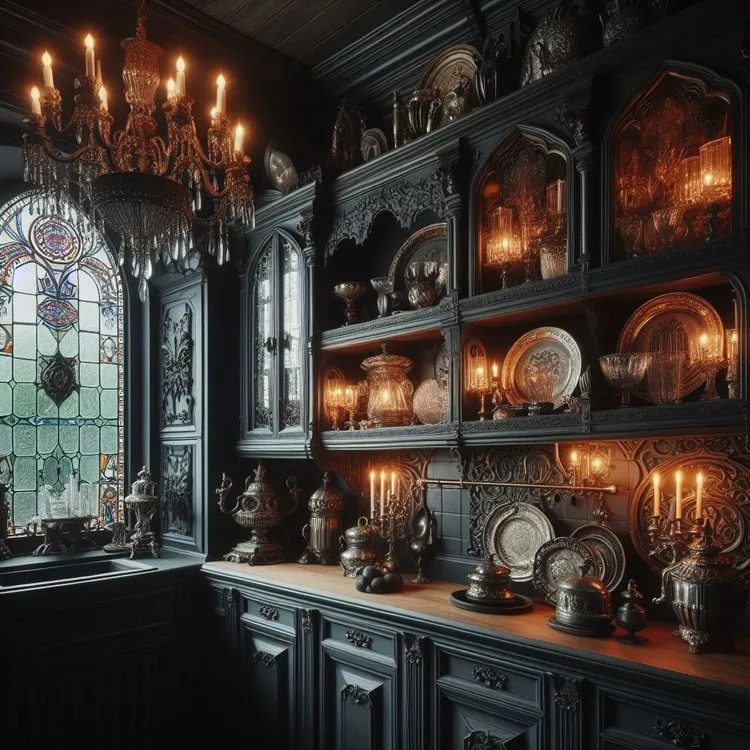
Choosing the right fixtures is crucial to creating the gothic look in your kitchen. Faucets, cabinet pulls, and other hardware should complement the overall design. Look for fixtures with an antique or vintage appearance; wrought-iron or brushed nickel finishes work well. The shape and style of the fixtures should also match the gothic aesthetic, with intricate details and ornate designs. The placement of the fixtures is important; they should be strategically placed to enhance the kitchen’s functionality and visual appeal. Consider the materials, as stone, wood, and wrought-iron elements will add to the theme. Be sure the scale of the fixtures is appropriate for the space and complements the overall design. Fixtures are important details that can tie the entire gothic look together, so choose wisely and carefully.
Materials and Textures in Gothic Kitchens
Materials and textures play a crucial role in creating the gothic atmosphere in the kitchen. Stone is a key element, consider using dark, veined marble or granite for countertops and backsplashes. Wood can add warmth and texture; dark wood for cabinetry and furniture is a staple. Wrought iron can be incorporated through lighting fixtures, hardware, and decorative accents. Textured tiles, such as those with a distressed or embossed finish, can add visual interest. Fabrics such as velvet, damask, or leather can be used for seating or window treatments. The combination of these materials and textures is essential for creating depth and visual interest, adding to the overall gothic aesthetic. Consider combining rough and smooth textures to create a contrast and enhance the visual appeal of the kitchen. The selection and use of these materials are important to establishing the gothic look.
The Role of Texture in Gothic Design
Texture is a crucial element in gothic design, adding depth and visual interest to the space. The combination of various textures is essential to creating a visually rich and engaging environment. Consider incorporating rough and smooth textures to create contrast, such as pairing a smooth, polished countertop with a textured backsplash. Using different materials with varied textures, such as wood, stone, metal, and fabric, adds dimension and personality. The placement of these textures is important; strategic placement of textured elements throughout the kitchen helps create a cohesive and balanced design. The texture will add an important level of visual interest and character to your gothic kitchen, allowing you to create a space that is both beautiful and unique.
Flooring Options for a Gothic Kitchen
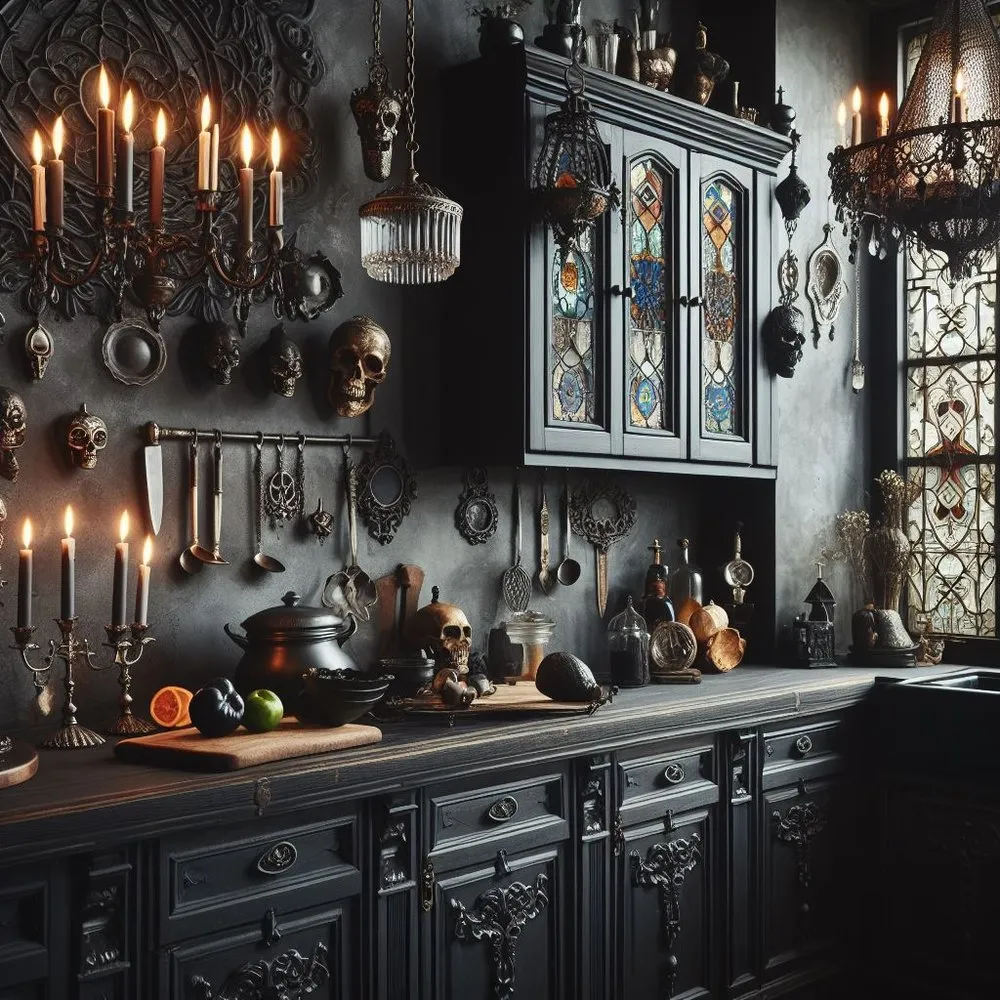
The flooring is an important aspect of the design and feel of a gothic kitchen. Dark-stained hardwood floors add a classic touch, bringing warmth and sophistication. Stone flooring, especially those with a dark, textured finish, can add to the gothic atmosphere. Consider adding patterned tiles, such as those with a geometric or gothic-inspired design, will enhance the thematic aesthetic. When selecting the flooring, consider the practical aspects. The flooring should be durable, as it will be subject to heavy foot traffic. The flooring should be easy to clean and maintain to ensure the kitchen remains both beautiful and functional. The color and texture of the flooring should complement the other elements in the room, such as the cabinetry, countertops, and wall colors. The flooring you choose will play an important role in establishing the gothic feel of your kitchen.
Modern Gothic Kitchens A Fusion of Styles
Modern gothic kitchens combine the classic elements of gothic design with contemporary features. This approach involves incorporating gothic details into a modern kitchen setting. You can achieve this by using black and white color palettes and then adding dramatic elements such as chandeliers or antique mirrors. Modern appliances can be integrated to provide functionality without sacrificing style. Sleek cabinetry with gothic-inspired hardware can create the right balance between modern and gothic design. The use of natural materials can add to the gothic feel, while the integration of modern design elements will create a kitchen that is both functional and stylish. The ultimate goal of the modern gothic kitchen is to combine the richness of gothic with the functionality of modern design.
Combining Gothic with Modern Elements
Combining gothic with modern elements in your kitchen requires a strategic approach to create a balanced design. The first step is to begin with a neutral base, using a black and white color palette to create a modern feel. This can be complemented by the addition of gothic-inspired details, such as ornate lighting fixtures or vintage hardware. To achieve the blend, consider the use of modern cabinetry with gothic-inspired hardware, creating a harmonious mix of styles. The textures of the materials are important, combining the clean lines of modern design with the textures of the gothic style. Accessories can add a final touch, such as antique mirrors, or gothic-themed artwork to further enhance the aesthetic. Combining these design elements will create a gothic kitchen that is both stylish and contemporary, offering a unique space to the user.
Maintaining a Black and White Gothic Kitchen
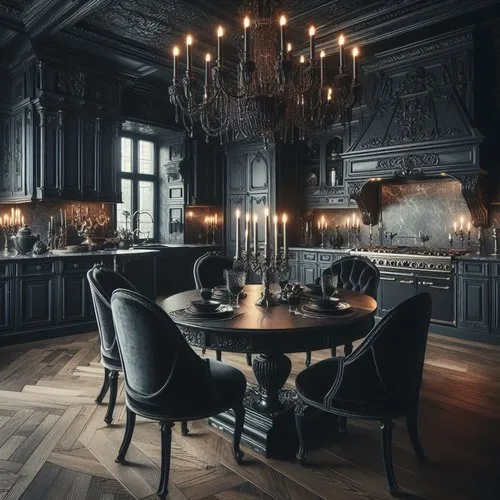
Maintaining a black and white gothic kitchen requires a dedicated approach, ensuring the space retains its pristine look. The contrast of black and white makes the kitchen more sensitive to dirt, dust, and smudges. Regular cleaning is essential, wiping down surfaces with a soft cloth and mild detergent. Clean the floors regularly, making sure to remove any spills immediately. Take care of the materials; protect wood surfaces with appropriate cleaners and avoid harsh chemicals. Inspecting and cleaning lighting fixtures regularly will help maintain their aesthetic appeal. The black and white theme may require more frequent cleaning and maintenance, compared to other color schemes. With regular and careful cleaning, you will keep the gothic kitchen looking its best. Consider the materials you are using and the cleaning techniques needed for them.
Cleaning and Upkeep of Gothic Elements
Cleaning and upkeep are crucial to maintaining the gothic elements of your kitchen, ensuring their longevity and appeal. When cleaning the gothic kitchen, start with a general wipe-down of surfaces using a soft cloth and a gentle cleaner. When cleaning the chandeliers and other light fixtures, be very careful. For wooden cabinets and furniture, apply the proper cleaners to preserve their finish. The antique mirrors and other glass surfaces should be cleaned to prevent streaks and maintain their clarity. Be very careful when dealing with textured surfaces, dust and dirt can accumulate in the grooves and crevices. Regularly inspect all hardware and fixtures for any signs of wear and tear. The cleaning and upkeep of the gothic elements is important to maintain the look of your kitchen. Your gothic kitchen will maintain its allure if you apply careful and regular maintenance.
